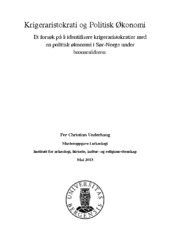| dc.description.abstract | The main goal for this Master thesis is to compare the Bronze Age culture from Southern Norway with the simultaneous culture in Southern Scandinavia, and further discuss if there was a similar war aristocracy in Southern Norway. Although the Bronze Age material from Norway has been widely examined by archaeologists earlier, it has never been seen in a comparative perspective with the goal to identify a society based on war aristocracy. I have looked at a comprehensive archaeological material of bronze from Southern Norway, mainly weapons as swords, spears and daggers. I have further seen this material in the light of many theories related to warriors, violence, war societies, identity and political economy. By using such a broad theoretical approach I have tried to shed light on many aspects of the meaning of weapons, and further what the symbolic meaning of the contexts of which they were found. The Norwegian archaeological material has mainly been found in graves, as deposits or votive offer, or from uncertain contexts. What thoughts might have been behind the actions which resulted in precious materials were put where they were? The geographical distribution of the weapons seems to have varied over time. In early Bronze Age there are many rich grave finds with weapons from Southwestern Norway, with a concentration in Rogaland County. In these grave finds there has been one particular sword type which had the greatest prevalence, which has been seen as the most precious sword own by the leaders of the society. Many other weapons, and also spears and daggers, have been found in this area in graves from early Bronze Age. The great number of graves in a relatively short period of time may indicate that there was a leading group of men in the society which ideology was based on war. It is a well known fact that monumental graves indicates legitimizing of power in a given area, and when these types of graves also have weapons with the buried body it is natural to see the buried here as a leader of a society based on war ideology. In late Bronze Age the concentration of power seems to move from the Southwestern part to the eastern part of Norway. From this period there is also known several rich weapons finds, particularly around Oslofjorden. The contexts of the finds seems be somewhat different from Southwestern Norway, though many are found in graves, also many finds seems to be concentrated in deposits or votive offerings. There is particularly one rich find from Svenes in Oppland County, about 30 spearheads, which indicates that the deposit was put there for later be recovered. This indicates that the leaders had the possibility to produce surplus for which they could buy weapons of precious weapons. Many finds in Eastern Norway seems to have been found connected to trading routes. This might indicate that the leaders here had to use weapons to defend their territory from others, and war must have been an important part of the everyday lives for those who lived in that society. | en_US |
